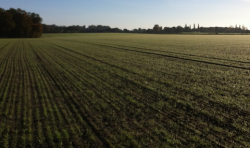 Abraham Lincoln
If given the truth, the people can be depended upon to meet any national crisis...
Abraham Lincoln
If given the truth, the people can be depended upon to meet any national crisis...
 Guildford news...
for Guildford people, brought to you by Guildford reporters - Guildford's own news service
Guildford news...
for Guildford people, brought to you by Guildford reporters - Guildford's own news service
Letter: We Need Sustainable Development With Defensible Green Belt Boundaries
Published on: 23 Apr, 2016
Updated on: 23 Apr, 2016
From Julian Lyon
Chairman of the Guildford Society and a leader of the Guildford Vision Group
Perhaps the answer to how the green belt is regarded lies in what is unsaid in Mr Paton’s letter: No One Is Arguing That The Green Belt Is ‘Sacrosanct’.
The green belt may not be sacrosanct but 70 acres of concrete on a piece of land that shares a fairly long boundary with Mr Paton’s property clearly is sacrosanct green belt land.
Yes, we urgently need affordable housing; yes, we need to deal with infrastructure deficits; yes we need to make the best use we can of brown field land. But we cannot rule out creating new sustainable communities with long-term defensible green belt boundaries.
I do not wish to pass judgement here as to whether Wisley Airfield (‘Three Farms Meadow’) can be such a sustainable community but I have absolutely no doubt we need to come up with development where affordable housing is viable.
 A site with an average plot purchase cost – before planning costs and on-and-off-site infrastructure – of £3,384 seems like a pretty good candidate to me, and so the argument probably demonstrates that green field sites may achieve more than Sir Paul Beresford MP’s vision of a Canary Wharf for Guildford.
A site with an average plot purchase cost – before planning costs and on-and-off-site infrastructure – of £3,384 seems like a pretty good candidate to me, and so the argument probably demonstrates that green field sites may achieve more than Sir Paul Beresford MP’s vision of a Canary Wharf for Guildford.
The best protection for the green belt may actually be to challenge the viability assessments for urban sites (such as SOLUM) which seem to point to much lower provision of affordable housing than we need (10% in SOLUM’s case) and the pre-consultation revised, Regulation 19, Local Plan aims to achieve.
Responses to Letter: We Need Sustainable Development With Defensible Green Belt Boundaries
Leave a Comment Cancel reply
Please see our comments policy. All comments are moderated and may take time to appear. Full names, or at least initial and surname, must be given.
Click on cartoon for Dragon story: Public Asked for Views on SCC’s Proposal for Reduced Speed Limits



Recent Articles
- Notice: GTA German Filmfest – July 2
- Letter: We Need More Yellow Boxes and Enforcement
- Notice: What’s On in July at Guildford Cathedral
- Greenfield, Greenbelt Site Deemed ‘Greybelt’ by Planning Inspector
- Letter: WBC’s CIL Recommendations Are Too Little, Too Late
- Letter: Yellow Box Fines Are Just a Money-raising Opportunity for SCC
- Drivers Caught in Yellow Box Junctions at the Dennis Roundabout Paid £81k to SCC
- Residents Hit By CIL Fees Should Be Offered Full Review, Says Overview Committee
- Plans For New Guildford Preschool Rejected On Road Safety Grounds
- Expert in AI Is New Head of the University of Surrey


Recent Comments
- David Roberts on New Electric Trains Now Arriving at Guildford – 100 Years After the First One Did
- Mark Stamp on Greenfield, Greenbelt Site Deemed ‘Greybelt’ by Planning Inspector
- Simon Dickinson on Drivers Caught in Yellow Box Junctions at the Dennis Roundabout Paid £81k to SCC
- Paula Smith on Comment: What Are We To Make of the GBC Executive ‘Reshuffle’?
- Jim Allen on Drivers Caught in Yellow Box Junctions at the Dennis Roundabout Paid £81k to SCC
- Wayne Smith on Plans For New Guildford Preschool Rejected On Road Safety Grounds
Search in Site
Media Gallery
Dragon Interview: Local Artist Leaves Her Mark At One of England’s Most Historic Buildings
January 21, 2023 / No Comment / Read MoreDragon Interview: Lib Dem Planning Chair: ‘Current Policy Doesn’t Work for Local People’
January 19, 2023 / No Comment / Read MoreA3 Tunnel in Guildford ‘Necessary’ for New Homes, Says Guildford’s MP
January 10, 2023 / No Comment / Read More‘Madness’ for London Road Scheme to Go Ahead Against ‘Huge Opposition’, Says SCC Leader
January 6, 2023 / No Comment / Read MoreCouncillor’s Son Starts Campaign for More Consultation on North Street Plan
December 30, 2022 / No Comment / Read MoreCounty Council Climbs Down Over London Road Works – Further ‘Engagement’ Period Announced
December 14, 2022 / No Comment / Read MoreDragon Interview: GBC Reaction to the Government’s Expected Decision to Relax Housing Targets
December 7, 2022 / No Comment / Read MoreHow Can Our Town Centre Businesses Recover? Watch the Shop Front Debate
May 18, 2020 / No Comment / Read More







Ben Paton
April 23, 2016 at 4:40 pm
Mr Lyon raises the issue of agricultural land in the centre of Ockham which is also known as land at the former Wisley airfield.
All he wishes to do is create a groundless aspersion that I have only raised objections to the development of this agricultural land because I live near it. If there were no better reason to object to a new town in the middle of Ockham than the location of my house then why is it that the Elmbridge BC, Highways England, and the Parish Councils of Ockham, Ripley, East and West Horsley, and Effingham as well as the Council for the Protection of Rural England, Surrey Wildlife Trust and the Royal Society for the Protection of Birds have all also objected?
Anyone reading my objections will find that I have only objected to the procedural irregularities and the multiple errors of fact in the planning application and the blatant breaches of planning policy.
Mr Lyon says that development should be sustainable. So why does he criticise me if I point out that this development in Ockham is unsustainable and does not comply with planning regulations? I am in good company: quite apart from the thousands of objection letters, the Settlement Hierarchy in the evidence base for the revised Local Plan describes Ockham as the second least sustainable place for development in the borough.
I have made no statement, written or verbal, that the green belt can never, in any circumstances, be built on, which is what I take ‘sacrosanct’ to mean in this context. All my objections to development on green belt land have been based on the principle that planning policy should be followed openly and transparently.
It was deplorable that professionally qualified people, like Mr Lyon, should give their endorsement to a revised Local Plan which was not supported by the most basic analyses such as a Transport Plan or Environment or Heritage studies.
It is even more deplorable that so-called professional people should argue that a demographic population projection that has not been disclosed and cannot be replicated by the public can be “objective” or forms a reliable foundation for building more houses in the coming two decades than in any previous twenty years in history.
Jane Robbins
April 23, 2016 at 11:02 pm
GBC’s revised Local Plan assesses whether a potential site is sustainable based on how far it is to walk to certain facilities such as a station, local shops, schools etc and has measured all these distances to come up with a sustainability score.
This makes complete sense as for one it cuts down on the amount of car journeys reducing congestion, pollution etc. It is also a very objective study and this allows people to understand the reasoning and get behind the logic. The NPPF [National Planning Policy Forum] also says that sustainability should be the golden thread running through local plans.
Then there is the green belt sensitivity study carried out by the GBC’s consultants Pegasus who have divided the borough into large land parcels and subjectively assessed these parcels as to whether they fulfil the main purposes of green belt.
Any site deemed to sit in a ‘high’ or ‘medium’ sensitive land parcel has been dropped from the previous draft. This is wholly in response to the pressure applied during the previous consultation from the Guildford Greenbelt Group who almost certainly consider all greenbelt Sacrosanct regardless of some claims.
But choosing sites on what land parcel they might sit in ignores the all important sustainability factor of potential sites.
Many other councils work out the sustainability of potential sites first, then assess whether those individual sites fulfil the main purposes of the green belt.
Its a shame Guildford hasn’t taken this approach as it would cut down on the dissent and make the plan more acceptable. I assume the planning inspector will pick up on this when he examines the plan.
This latest Guildford Local Plan has politics, rather than sustainability, as its golden thread.
Adrian Atkinson
April 25, 2016 at 7:04 am
What remains unsaid in Mr Lyon’s response is that he is “Director, Worldwide Occupier Services at Savills”. Savills, according to a letter they wrote: “represents [Wisley Property Investment] in respect of the ongoing promotion of a sustainable new settlement at Wisley Airfield.”
Savills have been representing and advising the Cayman Island tax haven company behind the deal since 2013. It’s a bit rich of Mr Lyon to have a go at Mr Paton without declaring his interest.
Valerie Thompson
April 25, 2016 at 11:59 am
I suggest that the author tries walking or cycling from the Wisley site to Effingham or Horsley station, or the local schools or surgeries. You might survive and if you do you should remember, no surgery or school is planned for Wisley until the first 500 houses have been built.
The theory is fine, but the practicalities are not, which was observed by all the councillors, when they visited Wisley in a bus.
Neville Bryan
April 30, 2016 at 1:18 pm
While all the new developments need to be critiqued, including Solum (no more Waitrose monstrosities please), I do not agree with Mr Lyon on his conclusion that building on Wisley, or for that matter any of the other green belt sites is a good idea.
Wisley, Gosden Hill, Blackwell Farm and now Normandy will all spark massive traffic in increases on our over-stressed infrastructure, which even the current (£1.5 billion) proposals are unlikely to alleviate.
I have three major reasons for this conclusion.
1. The SHMA (Strategic Housing Market Assessment) which defines the housing need, is a fundamentally unsound and developer biased document. I think Mr Lyon once agreed with me on this conclusion, as he was part of the many resident body organisations which opposed its previous (and lower) versions.
I still find it extremely suspicious to have an ONS population forecast reduction of 30% and yet a 6 per cent rise in SHMA need between versions. Once you start digging into the detail you start to expose the manipulation going on within the data set. No wonder various members of GBC – both elected, and salaried – are reluctant to get engaged in its detail. A low SHMA means less need to build on the green belt.
2. Doubling the amount of retail space in Guildford Town (the most sustainable part of the borough) is a ludicrous idea. The town centre master plan does contain some good ideas (I particularly like the idea of developing the river front for example), but the massive expansion of retail is ill-conceived.
Current market research forecasts a large reduction in retail floor space nationally due to the impact of on-line shopping. Even if expansion is considered here, the plan contains nowhere near enough new houses and flats next to the retail units to house the employed workers, who probably will not be able to afford them anyway.
This will drive more commuting and traffic into an already congested town. The town center plan needs a wholesale direction change in favour of well designed, high density housing, to include 40 per cent affordable or as in my personal definition – council houses.
It is also a nonsense that the flood plan area in the town centre is a restriction. This is easily overcome by under-floor car parks, and building on stilts – more expensive than building a field certainly, but very possible – ask the Dutch.
3. Lastly, I am not sure that any urban expansion communities of the size being proposed are really self sustaining. People coming in to live in them are likely to be working outside the new community (hence two cars per house), as self contained retail and employment levels will be low. A more recent Guildford example might be the recently closed Budgens on the Parklands/Stoughton estate, presumably as it was not viable. Maybe there are some other examples locally?
We all need to look again at the town’s opportunities. Any developments must not be made if they are to the detriment of all.